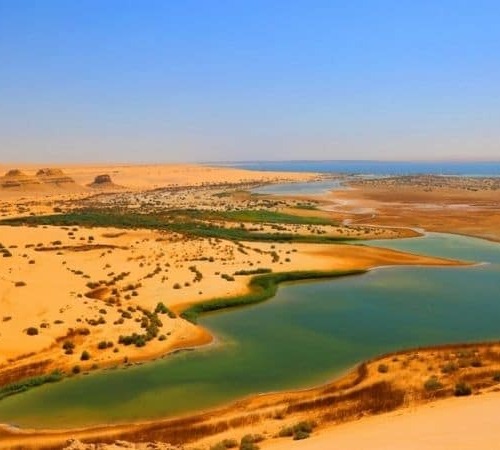KOM USHIM {KARANIS}
Kom Ushim: A Portal to Egypt’s Graeco-Roman Past
Kom Ushim, once known as Karanis, is a village steeped in history, located on the northeastern edge of the tranquil Birket-Qarun in Al Fayoum. For travelers journeying from Cairo through the southeastern desert, Karanis emerges as the first portal into the rich tapestry of Al-Fayoum’s past.
A Hidden Museum Amidst the Sands
In the heart of Kom Ushim lies a museum, almost concealed within its lush garden setting. Recently renovated, this intimate space houses a collection of artifacts from the prehistoric Roman era discovered in Al-Fayoum. Among its treasures are exquisite examples of Middle Kingdom art from Hawara, including the monumental head of a Roman god from Karanis, alongside an array of pottery and coins unearthed in the Faiyum region. The museum, with its thoughtful lighting and climate control, provides an immersive journey into antiquity.
The Enigmatic Al-Fayoum Portraits
Notably, the museum proudly displays two of the famed ‘Al-Fayoum Portraits’, with others residing in the Museum of Cairo. These portraits, crafted on linen or wood during the waning days of the Graeco-Roman period, were used to cover mummies. They reflect the Egyptians’ enduring belief in life after death and their tradition of immortalizing the deceased’s visage to guide spirits. Created with encaustic or water-based paints, these portraits showcase individuals in the prime of life, donned in their finest attire and jewelry. Their influence on Coptic art and the bridge they form between ancient Egyptian art and Middle Age portraiture are profound.
Karanis: A Glimpse into Ancient Everyday Life
Known as old Karanis, Kom Ushim is the gateway to the largest Graeco-Roman town site in Al-Fayoum, accessible from the museum grounds. Inhabited for roughly seven centuries post-dynastic rule, Karanis provides invaluable insights into the daily life, religious beliefs, and economic practices of its time. The University of Michigan initiated major excavations in 1925, marking the first comprehensive study of Graeco-Roman sites in Egypt.
An Architectural and Religious Tapestry
The archaeological site of Karanis, elevated 12 meters above the surrounding terrain, was established in the 3rd century BC by Ptolemy II, originally as a garrison. Over time, it blossomed into a thriving settlement, likely owing to its proximity to more populous northern cities. The town’s layout, with houses ranging from simple mud-brick structures to luxurious villas, reflects its varied social fabric.
Religious life in Karanis centered around two Ptolemaic temples, dedicated to an array of 27 deities spanning Egyptian, Roman, and Greek pantheons. The southern temple, plain yet majestic in limestone, honors Sobek, the crocodile-god, while the northern temple, more modest in scale, faces north and is characterized by its four slender columns.
Karanis Today: A Witness to History
Today, Karanis stands as a vital link to Egypt’s Graeco-Roman era, offering a rare glimpse into the lives of its ancient inhabitants. While much of the town has succumbed to time, the site continues to captivate archaeologists and visitors alike, serving as a living museum of a bygone age.
Created On March 18, 2020
Updated On January 24, 2024



